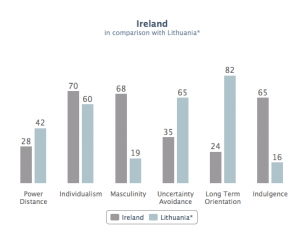For Dublin Bus one of the most beneficial aspects of having a cross cultural team is increased knowledge in the form of different languages. Ireland has a high number of migrants that has been significantly rising over the last few years, because of this a regular amount of customers who use Dublin Bus are foreign speaking. Through cross cultural teams Dublin Bus have a culturally diverse workforce which in turn means a wider range of languages is spoken by their employees. This means that bus drivers for Dublin Bus regularly speak not only English but additional languages that some customers also speak, allowing for efficient communication.
Additionally to increased knowledge cross cultural teams within Dublin Bus bring in a wide range of experience and this could be in the form of working within different international bus companies. This means that cross cultural employees previous experience could be used to create new ideas and find additional solutions to problems within Dublin Bus that a homogenous group may not find.
When Dublin Bus employ individuals from different cultural backgrounds there is always going to be differences and challenges to overcome. Hofstede’s cultural dimensions theory identifies that there are clear cultural differences between various nationalities and can be used by organisations such as Dublin Bus to highlight these differences and provide the organisation with an ability to make qualified assumptions about a particular cultures values (French, 2010, 56). Here is a diagram that highlights how the characteristics of Irelands citizens differ from one of the most common immigrants in the country, Lithuanians.

(Hofstede, 2014).
One of the most significant differences between the two nationalities is the score of masculinity, this dimension indicates that a society is driven by competition, achievement and success, Ireland scoring 68 means that the society is highly success orientated and driven whereas Lithuania’s score of 19 shows that the nation is reluctant about giving or receiving praise arguing that they could of done better (Hofstede, 2014).
One of the two most difficult challenges for Dublin Bus to overcome is communication and norms. For Dublin Bus driver’s, interactions with customers is a regular occurrence and language barriers and differing norms can become a challenge. Communication can affect the way drivers interpret information from the organisation as well as customers thus this can cause internal and external challenges for Dublin Bus and the employees day to day tasks. Norms can often create challenges similarly to communication in that even norms such as simple greetings and mannerisms can differ from culture to culture and what may be considered normal and acceptable to one culture may not be so to another thus there is a risk that customers may be confused and even offended when encountering a new employee who is unfamiliar with Irish culture.
